- Home
- Aaron Allston
Terminator 3--Terminator Dreams Page 2
Terminator 3--Terminator Dreams Read online
Page 2
All business, Mark rolled over onto his stomach and put his eyes to the sighting gear set up beside Kyla’s bipod-mounted rifle. “I don’t see it.”
“I think it dipped down into a depression in the road.”
Then it was there again, barely visible, a tiny dot moving like a car. Toward them.
“Transmit ‘Hell-Hounds Post One, contact, unknown, stand by,’” Kyla said. “And tell Daniel Ávila he was right again.”
“He’ll know.”
HH-2, flag,??, stdby.
John Connor read the message and swore silently. It was almost always too much to ask that any operation run without incident, but he always hoped.
Transport 4, an ancient Army truck kept miraculously alive by the mechanics of Connor’s Resistance movement, was backing up against the loading bay. The instant it came to rest, flush with the bay, its tailgate came down. Two men and a woman spilled out of the bed, and another woman out of the cab. In moments they deployed a long sheet that had once been a pair of recreational parachutes. Now tattered and unusable in their original role, they were painted as close as possible to a match with the gray of the parking lot, complete with occasional splashes of green to simulate weeds, and its handlers drew them up over the top of the truck. In the minutes it would take for the truck to be loaded, it would not be recognizable as a truck by the imaging satellites that still circled the Earth and fed their data to Skynet.
As the first of the dollies and pallet-jacks loaded with fabrication equipment and propelled by tired-looking but energetic Resistance fighters reached the rear of the truck, Kate rejoined her husband. She had her field phone in hand and looked worried—worried to the point of misery. “That’s Kyla, isn’t it?”
John nodded, waiting for the screen to update. “If this is anything but a false alarm, we might get out of here with the fourth truck, but we’re not going to get the fifth load.”
“We won’t even get the fourth truck out if we don’t use the Hell-Hounds for diversion.”
“I know.” John didn’t want to look at his wife at that moment.
If John Connor was the informal equivalent of the U.S. president, his Secret Service was Company A—the only company—of the Resistance 1st Security Regiment, the tiny branch of the armed forces devoted to Connor’s personal security. Company A was further broken down into several squadrons, each of which was used to ensure Connor’s safety or to undertake special missions that required an eclectic range of skills and nontraditional planning methods.
Though technically a branch of the military, the 1st Security Regiment tended to operate outside military procedure. Members were not addressed by military rank unless outsiders were present—it was enough to know who was in charge of the squad. Beyond that, everyone within the squad was equal.
Kyla Connor, John and Kate’s youngest child, was the junior member of Company A, Squad 3, the unit nicknamed the Hell-Hounds. And now, to get away with a truckload of antique machinery meant putting her at risk. Every time this sort of thing happened, John wondered if he would lose a child, and wondered if Kate would come to hate him because he had ordered it.
The screen changed:
HH-2, T800 Blondie, incoming.
That settled it. The contact Kyla had seen was a Terminator, one wearing a known set of facial features—dull-looking, approximately Scandinavian in appearance, muscular as a twentieth-century weight lifter. It was nicknamed Blondie.
“So they haven’t scrapped all the T-800s after all,” Kate breathed.
“I figured they hadn’t,” John said. “Skynet’s probably retiring them as they get harder to maintain, stripping their usable machinery rather than building new, dumping only those that aren’t cost-efficient.” He began keying in a new command.
Kate read what he was typing. “Dammit.”
5T go2ground
HH play fox
“Truck five, go to ground,” Mark recited. “Hell-Hounds, play fox.”
“Fox, hell,” Kyla said. “Foxes don’t have sniper rifles or high explosives. Does Ten want me to go after him now? I need an answer in about sixty seconds.”
“Gotcha.” Mark keyed in the question in short form and got an answer in moments. “He says take your best shot and then we move up to join him and Earl.”
“Wind,” she said.
Mark returned his attention to his gear. “Nothing registering.”
In Kyla’s scope view, the vehicle bringing the Terminator to them topped another rise. It was a convertible, 2000-era, cream yellow, lacking a windshield. It was making good time, perhaps eighty miles an hour, about as fast as anyone could drive on the partially ruined highway without crashing. The air flowing across the car whipped the blond hair of the assassin-machine driving it.
Kyla had three options. She could put a round into the Terminator’s chest, the easiest shot. If she were very, very lucky, the round might penetrate, might even damage one of the robot’s hydrogen-fuel power cells and cause the Terminator to detonate; the explosion would be ferocious enough to destroy a portion of highway around it. But the most likely scenario for a chest shot was that it would impart enough kinetic energy to disrupt the robot’s reflexes for a moment, perhaps causing it to crash. It wouldn’t do the robot any real harm, unless the crash was spectacular.
She could aim at the robot’s skull, a more difficult shot, but the fact that the skull had lighter armor and less mass in general meant that the impact could conceivably do some real damage. Kyla had killed Terminators, one T-800 and two T-600s, with single head shots, and if she were very lucky now, she might repeat that feat. But her target was moving, so it would be easier to miss altogether.
Or she could aim at the left front wheel. At this angle, the shot was nearly as difficult as the head, but would almost certainly result in a wreck. And a wreck was the preferred outcome, regardless of whether it harmed the Terminator; without wheels, its land speed was reduced. It would not be able to get to the Eosphor Technologies site as quickly. The tire was the most sensible option.
She zeroed in on the Terminator’s head. Long ago, Daniel Ávila had taught her to play chess. She hadn’t liked the game much. It seemed meaningless to her. But it had helped her learn to think tactically, and she had discovered the distinction between playing to win, playing not to lose, and playing to aggravate a superior opponent by losing very slowly.
With Terminators, you played to win. Always. “Taking my shot,” she said. “Death to the toasters.”
“Death to the toasters,” Mark replied. It was the catch-phrase of the Hell-Hounds and had caught on with other units as well.
The convertible entered the long, straight, relatively undamaged section of highway overpass Kyla and Mark had picked out this morning. She would know exactly when it reached the 1,000-yard mark, measured from this roof edge; they had calculated the shot when they’d set up here hours ago.
Her rifle was a Barrett M99, fifty inches and twenty-five pounds of black steel and brushed-silver aluminum. It fired .50-caliber rounds that struck their targets with several times the foot-pounds of energy of other sniper rifles at comparable ranges. To those who concerned themselves with the aesthetics of small arms, it was a beautiful piece, elegant in its simplicity, a near-perfect marriage of form and function.
It had been manufactured a year before Judgment Day. That’s what its original owner, Sergeant Tony Calhoun, member of a Los Angeles Police Department SWAT team, had told her; it had been his personal property rather than a department-issued weapon. Calhoun, away from Los Angeles when the bombs had dropped on Judgment Day, had joined an ad hoc militia that had eventually become part of John Connor’s Resistance. He had trained many of its riflemen and snipers. In Kyla Connor, he’d found an ideal pupil—someone who was as calm and focused as the Terminators the snipers hunted.
When the cancer that was ultimately to take his life metastasized, Calhoun gave his rifle to Kyla, over the protests of Tony’s own son. When Calhoun died a few weeks later, Kyla
had words engraved on the barrel: TONY CALHOUN, plus the dates of the man’s birth and death. The rifle was his only gravestone. Kyla suspected that it would probably be hers as well.
Kyla let out her breath, willing her body to absolute stillness—absolute except for her right index finger. With a slow, sure draw of the trigger, she fired.
* * *
The Terminator saw the distant glint. Its threat processor popped up a display of probabilities. The heaviest weighting, sixty-seven percent, was that the glint was a reflection from a piece of broken glass. Another twenty-two percent was that it was an emission from small-arms fire. That percentage would increase as the Terminator neared its objective, the search zone Skynet had defined as part of its mission.
Even if it was enemy action, however, the likelihood of it having any effect was extremely low. The glint was characteristic of small-arms fire, not rocketry. And at this range, an estimated one kilometer, small-arms accuracy was extremely low.
Then the .50-caliber round smashed into the Terminator’s left eye and tore out through the side of its skull behind its temple.
The impact snapped the robot’s head back and to the left. Temporary disruption of its sensory input and its motor coordination caused the robot to spasm and lose control of the steering wheel. The vehicle began a sharp drift rightward toward the overpass rail.
Even with visual senses temporarily off-line and intellectual processes overloaded, the Terminator knew that an impact with the corroding rails and concrete barriers would probably result in their destruction. The car would punch through, hurling through the air, smashing into the ground below. It might explode, causing the robot additional damage. This was unacceptable.
The Terminator slammed on the brake. But in its impaired state it failed to factor in the structural integrity of the frail vehicle it controlled. Its foot smashed through the brake pedal and the salt-corroded floorboard, striking the highway passing beneath.
* * *
One block away, an aging black man and a younger white man, both dressed in camo and carrying heavy backpacks, raced toward the highway on foot. In clear view of the highway overpass, they saw the convertible crash through the overpass rails, barrel-rolling as it dropped the thirty feet to the ground. It hit, its front end accordioning, its rear end wrapping around and collapsing on the driver.
The older man, Earl Duncan, breathing heavily, said, “Good girl, Kyla. Hollywood quality.”
The younger, Lieutenant David Zimmerman, called Ten by the members of his team, took the opportunity to pull a weapon from his backpack. It was a tube a little over a yard long, a handle and trigger descending from it toward the rear, a crude sight protruding from it on one side nearer the middle, a bulbous mass attached to the front. It was a rocket-propelled grenade, a one-shot weapon that could, under rare and lucky circumstances, take out a robot as powerful and heavily defended as a T-800. “Let’s go.”
“Let’s wait. If it crawls out before we get right up on it, it can’t surprise us.”
Ten growled to himself. The one member of the team he led whose tactical sense was better than his was Earl. Ten propped himself behind the burned hulk of a Dodge SUV and sighted in on the car.
The smashed convertible caught fire along the underside. It shifted a little as its driver struggled; then it exploded. This wasn’t a big, spectacular explosion, just a smallish boom and the eruption of a mushroom cloud no bigger than the car had been; the smoke from the cloud rose to drift serenely beyond the overpass.
“Gas tank probably full,” Ten said. “Else the explosion would have been bigger.”
“And that means—?”
“It probably came straight from one of San Francisco’s old military bases. Just like Daniel predicted.”
The burning hulk, less cream yellow than black now, shifted and a figure rose out of the middle of it.
The T-800 was a bit the worse for wear. Its clothes, hair, even its skin were on fire. Unconcerned, it stepped out from the burning wreckage and took a look around. It reached down to shift the demolished car. Earl and Ten both noted that it didn’t have any sort of weapon in hand. It was probably searching for whatever long arm it had brought.
Ten fired. The RPG leaped away from him with a whoosh and the stench of burning propellant. The missile struck just beneath and between the Terminator’s legs, exploding in a larger and louder detonation than the one before.
Earl and Ten watched the burning Terminator fly through the air to crash, a short distance away, into one of the concrete support pillars that held up the overpass. From his field pack, Earl pulled out an RPG of his own.
The Terminator was up immediately, its body now an odd combination of black burned flesh and silvery undercarriage. It turned an eye—only one was still red and glowing—toward Earl and Ten, and began running … but not toward them. It moved off at an angle away from the two men, keeping its cover behind successive support pillars.
“It knows where it’s going,” Earl said.
“Dammit.” Ten grabbed the mike on his lapel. Now they didn’t have enough time to fiddle with field phones and key in text messages. “Hell-Hound One to Starling, bug out, repeat bug out. You have about sixty seconds.” He began running—not after the Terminator, but in a direct line toward the Eosphor Technologies building. Maybe he and his Hell-Hounds could get within line of sight of the building before the Terminator reached it; maybe they could exceed the values set up for its self-preservation protocols and cause it to turn against them instead of the others. Maybe.
Breathing heavily, Earl Duncan ran in his wake.
C.2
“Go, go, go, go!” Kate shouted. She switched her attention from the pair of men wheeling oversize file cabinets into the truck bed to the trio maneuvering a pallet-jack loaded with a large silk-screen frame. “That’s your last item. Don’t go back for more. Get the pallet-jack into the back.” She walked deeper into the warehouse, addressing the next group in line. “What’s that? Film? Negatives. Load it.” She shouted further into the building, projecting to be heard through the open doorways, “Everyone else, drop what you’re carrying. Bug out!”
John ignored her, trusting her to arrange the immediate evacuation of all personnel in the building. He kept his attention on his field phone and the digital countdown he’d set in the upper right of the screen. It was down to twenty-nine seconds. “Daniel, bring up the Humvee, now.” Men and women were rushing past him, loading into the back of the truck. He heard the truck’s engine firing up, an asthmatic rattle demonstrating just how old and fragile the machinery really was. “All scout units except Hell-Hounds, make for your rendezvous points. Hell-Hounds, give me an update.” Now it was nineteen seconds.
* * *
Ten and Earl caught occasional glimpses of the Terminator as it charged directly toward Eosphor Technologies. The machine ran across streets and parking lots, smashing effortlessly through cyclone fences. Moving like a track champion, it leaped over low obstacles such as dead cars and cinder-block walls. The two Hell-Hounds steadily lost ground to the machine, which could run at two or three times their speed in a flat straightaway and was comparatively even faster in broken terrain such as this.
The Terminator reached the middle of a four-lane street that crossed at nearly right angles to its path. There was a sound like a ball bearing hitting a hubcap at the speed of sound, and the T-800 fell on its rear end. The crack from Kyla’s sniper rifle followed a split-second later.
The Terminator was up in an instant. The second shot hadn’t damaged it enough to alter its running pace; still, it held a hand up over its face as if shielding its eyes from the sun.
Ten, running a block back across the rubble of a fast-food place that now spilled across its parking lot, grinned. The machine was protecting its skull and remaining eye. They’d hurt it. It was always good to hurt a Terminator. If they could just get within hand-to-hand range without getting killed, the devices packed in the top of Ten’s field pack would do more t
han hurt it.
Kyla’s rifle spoke again, noises like distant trees suddenly being broken in half. Three times bell-like noises of her bullet impacts rang from the Terminator’s torso; finally the machine slowed, its head swiveling in a ten-degree arc as it sought to discover Kyla’s hiding place.
Earl, panting, came up alongside Ten and leaned across the hood of a U.S. Postal System delivery truck. There were human bones and patches of USPS uniform in the front seat. Earl still held his RPG. “Taking my shot,” he said, his voice hoarse.
Ten had to marvel. Earl Duncan was well past sixty, the oldest member of the Hell-Hounds, and still in good enough shape to keep up with the others in urban operations. “Go for it.”
Earl fired, and Ten watched in a dispassionate sort of fascination as the explosive head leaped from the disposable weapon. The Terminator disappeared in a ball of fire and smoke, then reappeared several yards ahead, rolling to a stop against the remains of a filling station on the far side of the street. The ruins shielded it from further fire by Kyla.
The robot was up in a moment, but it had suffered further damage. A connector at the heel of its right leg, performing the same function as the Achilles tendon, had come free. Now the Terminator’s right foot was loose, no longer under control of the computerized algorithms that simulated human movement.
The Terminator turned toward the filling station and smashed its way in through the surviving glass of its front window. Ten and Earl hurried after it. A moment later, the robot smashed out through the back door of the station; Ten could no longer see it, but could hear its newly awkward steps.
Now they’d forced it to move within cover to avoid more .50-caliber rounds and RPG warheads. They were wearing it down. But they couldn’t count on wearing it down fast enough.
* * *
John saw the not-too-distant fireball of the Hell-Hounds’ second RPG attack. Beside him, the last of the Operation Starling workers piled into the back of Transport 4. As Lieutenant Tom Carter, the aging officer who was one of John’s primary technical experts, hauled the tailgate up, John kicked it, slamming it into place, and waved at the driver’s-side mirror. “Go!”

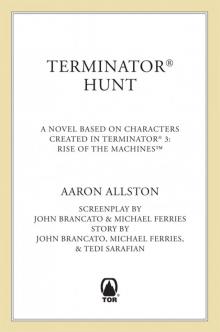 Terminator 3--Terminator Hunt
Terminator 3--Terminator Hunt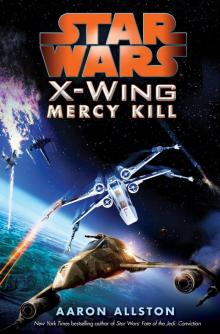 Mercy Kil
Mercy Kil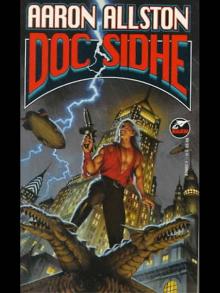 Doc Sidhe
Doc Sidhe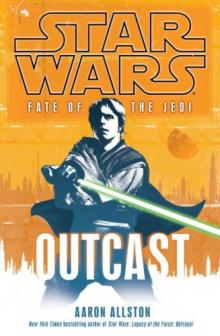 Star Wars: Fate of the Jedi: Outcast
Star Wars: Fate of the Jedi: Outcast Fate of the Jedi: Backlash
Fate of the Jedi: Backlash Mercy Kill
Mercy Kill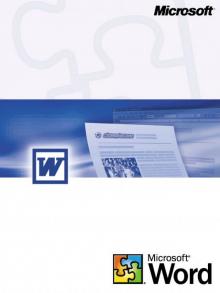 Rebel Stand
Rebel Stand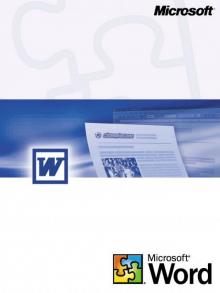 Wraith Squadron
Wraith Squadron Star Wars: X-Wing VII: Solo Command
Star Wars: X-Wing VII: Solo Command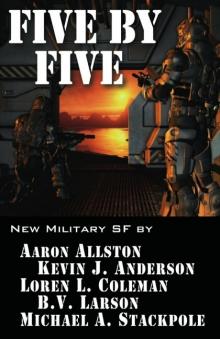 Five by Five
Five by Five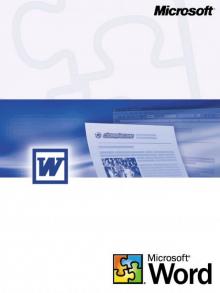 Solo Command
Solo Command Star Wars: The Clone Wars Short Stories: The League of Spies
Star Wars: The Clone Wars Short Stories: The League of Spies Sidhe-Devil
Sidhe-Devil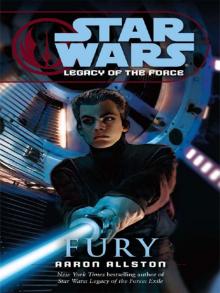 Star Wars: Legacy of the Force: Fury
Star Wars: Legacy of the Force: Fury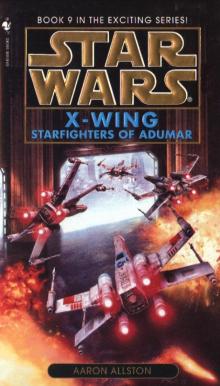 Starfighters of Adumar
Starfighters of Adumar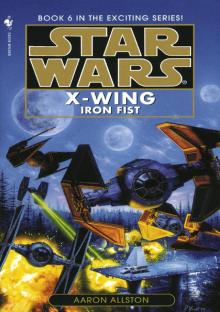 Star Wars: X-Wing VI: Iron Fist
Star Wars: X-Wing VI: Iron Fist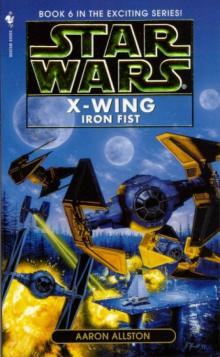 Star Wars - X-Wing - Iron Fist
Star Wars - X-Wing - Iron Fist Exile
Exile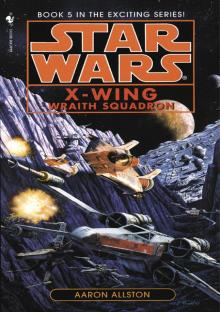 Star Wars: X-Wing V: Wraith Squadron
Star Wars: X-Wing V: Wraith Squadron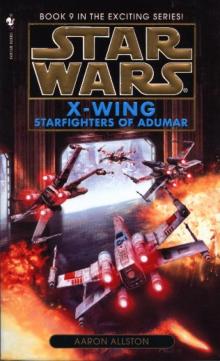 Star Wars - X-Wing - Starfighters of Adumar
Star Wars - X-Wing - Starfighters of Adumar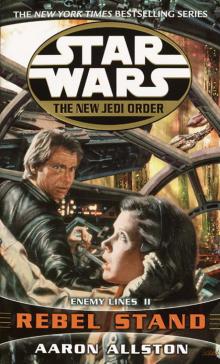 Rebel Stand: Enemy Lines II
Rebel Stand: Enemy Lines II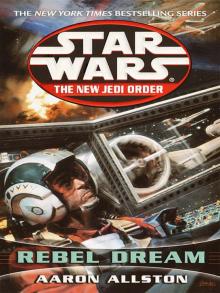 Rebel Dream: Enemy Lines I
Rebel Dream: Enemy Lines I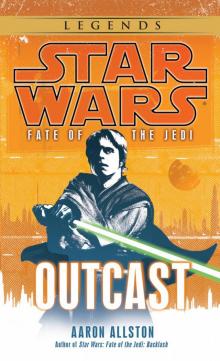 Outcast
Outcast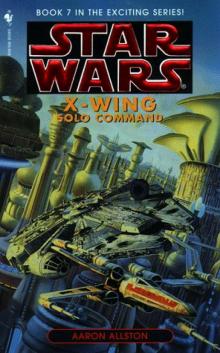 Star Wars - X-Wing 07 - Solo Command
Star Wars - X-Wing 07 - Solo Command